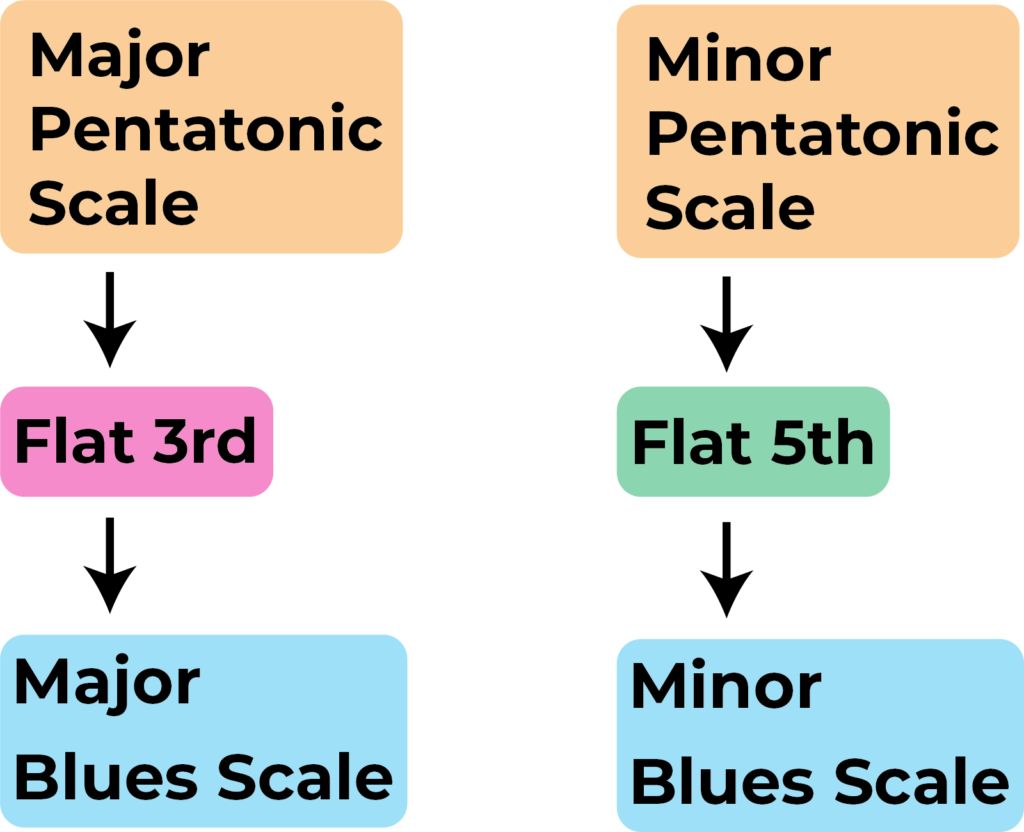The blues scale is one of the most common scales to learn within music theory, but it is extremely important to note that there is not just one blues scale, there are in fact two different ones. The major blues and the minor blues scales. But if someone asks you to play a blues scale they will most commonly be referring to the minor blues scale, so this is where we will start.
Blues scales are extremely common in all music including blues music, classical, pop, jazz, rock and more!
The minor blues scale
To understand the minor blues scale fully, we must first explain what the minor pentatonic scale is. The pentatonic scale is a five note scale, made up of notes from the natural minor scale. To form the minor pentatonic scale you will use the
1, 3b, 4, 5, 7b
If we were to play a minor pentatonic scale starting on C, we would have the following notes C, Eb, F, G, Bb. If you would like to learn more the see our complete guide to the pentatonic scale.

To then turn this minor pentatonic scale into a minor blues scale we simply need to then add the flattened fifth above the root. The minor blues scale will therefore have the following notes: C, Eb, F, Gb, G, Bb. Below you can see the c minor blues scale.

If we write this out using our scale degrees, the minor blues scale is therefore built using: 1, 3b, 4, 5b, 5, 7b. You can then use this formula and apply it to any key to form a minor blues scale. Take a look at the g minor blues scale written below!

Let’s now take a look at our other blues scale, the major blues scale.
The major blues scale
The major blues scale is similar to the minor blues scale but it has a more uplifting major sound! The major blues scale is built on the major pentatonic scale, much like how the minor blues scale was built from the minor pentatonic scale.
To really get to grips with the major blues scale, we will need to look at the major pentatonic scale first.
The major pentatonic scale formula is simply 1, 2, 3, 5, 6. In C major pentatonic scale would therefore have the notes C, D, E, G, A.

The major blues scale differs only by one note from this, much like the minor blues scale, we simply add the flat third. So the formula for the major blues scale is as follows – 1, 2, 3b, 3, 5, 6. The C major blues scale will therefore have the notes C, D, Eb, E, G, A

Let’s look at one more example of the major blues scale. How about the D major blues scale. The notes in this major blues scale will be D, E, F, F#, A, B.

The Blue note
As you can see both the major blues scale and the minor blues scale only differ from their relevant pentatonic scales by one note. In both cases, this note is the flattened third! These flat thirds are referred to as blue notes. These blue notes are the only notes that separate the major pentatonic scales from the major blues scales and the minor pentatonic scales from the minor blues scales!
The scale degree of the blue note in the minor blues scale is the flattened fifth and the scale degree of the blue note in the major blues scale is the flattened third.

Using the blues scale
The blues scale is fundamental to many music compositions! But you will most commonly see it within jazz, popular music or blues music. You can use it to improvise blues music but it is also common in jazz improvisation. Ensuring that you are comfortable playing the minor blues scale as well as the major blues scale will you give you the confidence to write melodies and improvise in all different genres of music.
The major and minor blues scales must not be confused with the 12 bar blues chord progression. Within the 12 bar blues scale it is most common to use a chord progression formed using the major scale or a minor scale triads. To learn more about the 12 bar blues with our guide.

Make sure to spend time practicing playing blues scale exercises and basic blues scales. The blues scale has the ability to add so much more depth to your compositions. Remember that it is important to play a scale that will work with the chords in the 12 bar blues.
In a 12 bar blues in D (I, IV, V) you can play:
- The minor blues scale of the whole progression.
- The D major blues scale over the D7, the G major blues scale over the G7 and the A major blues scale over the A7.
Playing the Major Blues scale on Guitar
The blues scale can be played on guitar using in a variety of positions and it uses the basic shape of the major and minor pentatonic scales.
The positions are the same for the both major and minor blues scale, but the the root notes will change. For examples, the C major blues scale is the same as the A minor blues scale (because A minor is the relative minor of C major).
In the scale shapes below, Position 2 of the minor blues scale is the same as position 1 of the major blues scale. This means that it can be easy to switch between them and you only have learn 5 positions! Just remember to keep an eye of where the root notes are!
Positions for f Minor Blues Scale
The red dots indicate the root notes and the blue dots are the blues notes.





Positions for G Major Blues scale
The green dots indicate the root notes and the blue dots are the blues notes.





What’s next…..?
- Learn about the scale that underpins the blues scale, the major and minor pentatonic scale.
- Here’s our complete guide to scales for a summary of the different scales you might meet.
- Seventh chords are used a lot in blues progressions, learn more in our guide to seventh chords.
